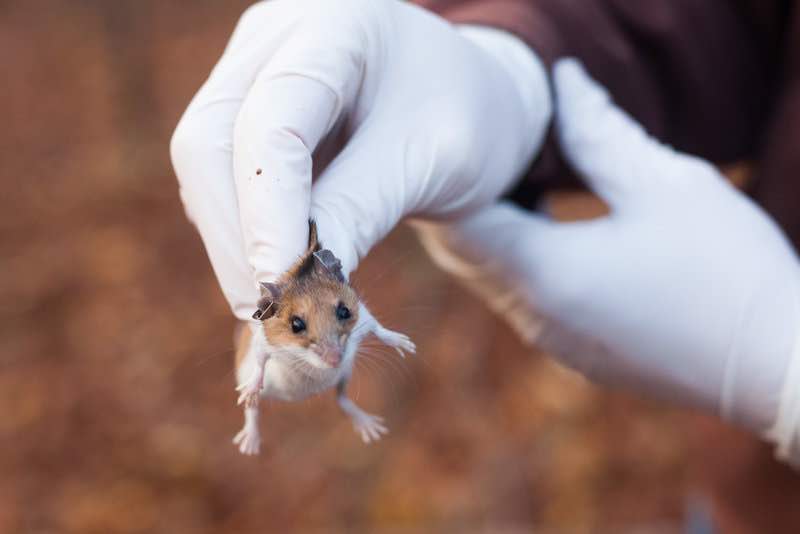from NPR--Morning Edition, March 6, 2017
by Michaeleen Doucleff and Jane Greenhalgh Last summer Felicia Keesing returned from a long trip and found that her home in upstate New York had been subjected to an invasion. "There was evidence of mice everywhere. They had completely taken over," says
Keesing, an ecologist at Bard College. It was a plague of mice. And it had landed right in Keesing's kitchen. "Not only were there mouse droppings on our countertops, but we also found dead mice on the kitchen floor," says Keesing's husband, Rick Ostfeld, an ecologist at the Cary Institute of Ecosystem Studies in Millbrook, N.Y.
(GLA Note: Ostfeld is a member of GLA Scientific Advisory Board). The Hudson River Valley experienced a mouse plague during the summer of 2016. The critters were everywhere. For most people, it was just a nuisance. But for Keesing and Ostfeld, the mouse plague signaled something foreboding. "We're anticipating 2017 to be a particularly risky year for Lyme," Ostfeld says. [caption id="attachment_4172" align="alignright" width="200"]
 Rick Ostfeld and Felicia Keesing have been studying Lyme disease and ways to stop it for more than 20 years. The couple has come up with a way to predict how bad a Lyme season will be a full year in advance.
Rick Ostfeld and Felicia Keesing have been studying Lyme disease and ways to stop it for more than 20 years. The couple has come up with a way to predict how bad a Lyme season will be a full year in advance.
Stephen Reiss/for NPR[/caption] Keesing and Ostfeld, who have studied Lyme for more than 20 years, have come up with an early warning system for the disease. They can predict how many cases there will be a year in advance by looking at one key measurement: Count the mice the year before. The number of critters scampering around the forest in the summer correlates to the Lyme cases the following summer, they've
reported.
The explanation is simple: Mice are highly efficient transmitters of Lyme. They infect up to 95 percent of ticks that feed on them. Mice are responsible for infecting the majority of ticks carrying Lyme in the Northeast. And ticks love mice. "An individual mouse might have 50, 60, even 100 ticks covering its ears and face," Ostfeld says.
So that mouse plague last year means there is going to be a Lyme plague this year. "Yep. I'm sorry to say that's the scenario we're expecting," Ostfeld says.
He's not exactly sure which parts of the Northeast will be at highest risk.But wherever Lyme exists, people should be vigilant, says epidemiologist Kiersten Kugeler at the Centers for Disease Control and Prevention.
"Whether it's a bad season or not, there's still going to be a lot of human cases of tick-borne diseases," she says. "What's important for people to know is that the ticks are spreading to new areas — and tick-borne diseases are coming with them."
Back in the early '80s, the disease wasn't that big a problem. Cases were confined to two small regions: western Wisconsin and the area from Connecticut to New Jersey. Since then, Lyme cases have shot up in number and spread in all directions: "The only place that they haven't really spread is into the Great Lakes and the Atlantic Ocean, for obvious reasons," says biologist
Rebecca Eisen, who's also at the CDC. Now Lyme is present in more than 260 counties, the CDC
reported in 2015. The disease shows up in Maine, swoops down the East Coast into Washington, D.C., and southern Virginia. Then it hops to the Midwest into northern Indiana, Illinois, Wisconsin and Minnesota. There are also small pockets of Lyme on the West Coast. Since the early '90s, reported cases of Lyme disease have
tripled, to about 30,000 cases each year. The CDC thinks the actual number is 10 times higher. "We think the true burden of Lyme disease in the U.S. is about 300,000 cases," Kugeler says. "Lyme disease is quite a big public health problem." The reasons for this Lyme explosion are many, Ostfeld says. Climate change is part of it. The surge in deer — which feed ticks and spread them around — has also been a factor. But Ostfeld has found another reason, something that happened more than 200 years ago. Today the Hudson River Valley in upstate New York is gorgeous. The hills are covered with oak forests, and the valleys are patchworks of hayfields and farms. But Ostfeld says the area didn't always look like this. When the Europeans came here hundreds of years ago, they clear-cut nearly all of the forests to plant crops and raise livestock. "They also cut down trees for commercial use," Ostfeld says, "to make masts for ships, and for firewood." Since then a lot of the forest has come back — but it's not the same forest as before, he says. Today it's all broken up into little pieces, with roads, farms and housing developments. For mice, this has been great news. "They tend to thrive in these degraded, fragmented landscapes," Ostfeld says, because their predators need big forests to survive. Without as many foxes, hawks and owls to eat them, mice crank out babies. And we end up with forests packed with mice — mice that are chronically infected with Lyme and covered with ticks. So all these little patches of forest dotting the Northeast have basically turned into Lyme factories, spilling over with infected ticks.
Read the entire article on NPR.

 Rick Ostfeld and Felicia Keesing have been studying Lyme disease and ways to stop it for more than 20 years. The couple has come up with a way to predict how bad a Lyme season will be a full year in advance.
Rick Ostfeld and Felicia Keesing have been studying Lyme disease and ways to stop it for more than 20 years. The couple has come up with a way to predict how bad a Lyme season will be a full year in advance.






-2.jpg)
